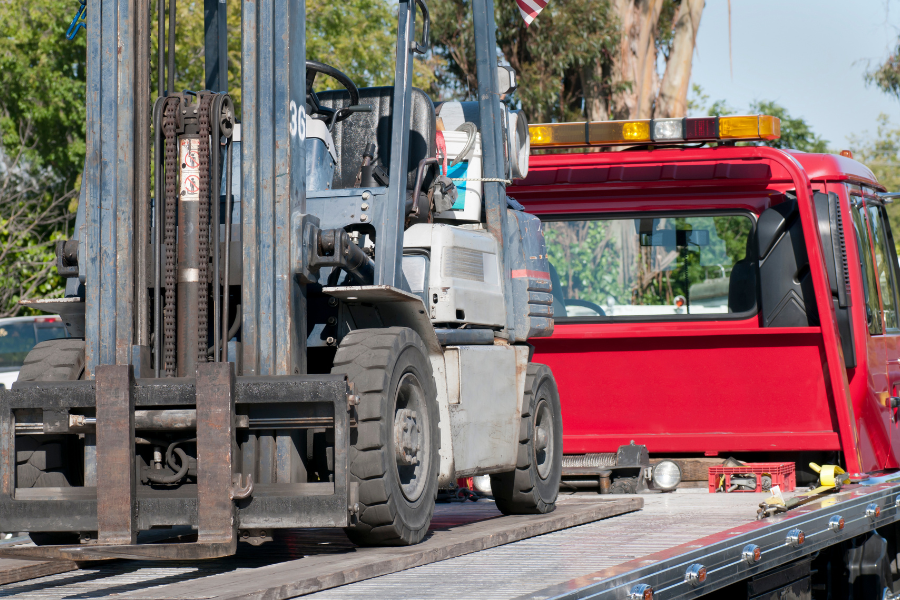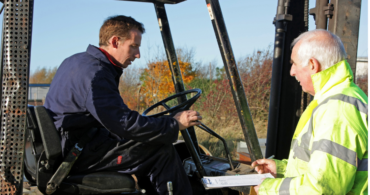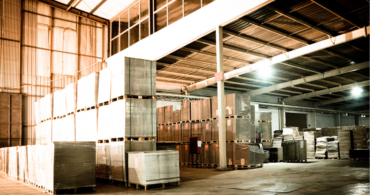Forklifts are excellent at moving heavy loads throughout a facility. However, what happens when the heavy load that needs to be moved is the forklift itself? Well, that’s when you need to rely on a fork truck transport.
Forklifts move on their own. It’s one of the main selling points for any forklift. As long as you only need a forklift to operate within a single facility or general area, you will find that a forklift’s propulsion suits your purposes. However, since it is illegal for a forklift to operate on public roads, there are several reasons a business may need a forklift transport, such as:
- Site transfers: In a large industrial complex, it may not be feasible or economical for a forklift to travel across the site on its own power. The same is true for companies that have multiple locations. Transporting forklifts between sites is essential to maintaining a smooth workflow.
- Facility reorganization: Anyone reorganizing a warehouse or workspace layout may need to relocate a forklift fleet temporarily.
- New purchases or leases: Similarly, a company upgrading to a new facility may need to transfer its existing forklifts to the new location.
- Maintenance: Most forklift repair and maintenance services occur on-site (such as Texas Motive Solutions’ forklift battery repair). However, serious issues may require transport to a maintenance facility.
Forklift transport considerations
There are companies that specialize in transporting heavy machines like forklifts. Pricing is based on several factors, such as the number of forklifts, type of forklifts, total weight and travel time. The final cost can range from hundreds to thousands of dollars.
If you have the necessary equipment, it may make sense to transport the forklifts yourself. Before you decide, there are several factors to keep in mind:
- Safety: Regardless of transportation method, a forklift must be securely loaded and tied down. Improper transport techniques pose significant safety risks.
- Preserving the equipment: Forklifts are tough and withstand a lot during an average shift. However, that does not mean they can handle an unsecured trip during transport. Rough or careless transport can lead to equipment bouncing around or careening off a truck. Properly transported forklifts are less likely to suffer damage during transit, leading to longer lives and lower maintenance costs.
- Maintaining timelines: Equipment downtime, such as when a forklift is not forklifting, is costly for a company. Anyone unfamiliar with fork truck transport may double or even triple the time a forklift spends on the truck, leading to lost productivity.
- Compliance: It’s not uncommon for regions to have strict regulations governing heavy equipment transport, like forklifts. Adhering to legal and safety standards helps avoid fines and penalties. Be sure to know your local laws and directives.
How to load a forklift
Two primary forms of transportation are used to move forklifts over long distances: trailers and flatbeds. A trailer is an enclosed structure that can help protect the forklift against the weather and other types of damage. A flatbed is an open structure that exposes the forklift but is often easier to load, secure and unload.
Before loading a forklift on either a trailer or flatbed, some safety precautions will help ensure you, your staff and your equipment remain safe and secure.
First, and perhaps most important, use protective gear. This includes PPE for you and your employees, such as heavy gloves and protective footwear, and guards, straps and padding to protect your forklift. Next, just like you need to know the weight of the cargo you lift with a forklift, you also need to know the weight of your forklift to ensure that the transport can handle the load. Finally, inspect the transport to make sure it is in proper working order, including the tires, lights and brakes. Be sure to look for any damage or issues that might impede the loading process. Remove any loose or detachable parts that could be damaged during transport and check the fluid levels and tire pressure.
How to load a forklift on a trailer or a forklift on flatbed
The steps to load a forklift onto either a trailer or flatbed are remarkably similar.
Step 1: Prep the forklift.
Think of this step like you were renting a car. You know how you don’t want to be charged for that previously dented fender? It’s like that, but in this case, you want to make sure the forklift will operate when it arrives at its destination. Be sure to remove any loose or detachable parts that could be damaged during transport, and check and adjust fluid levels and tire pressure.
Step 2: Prep the transport.
You should have inspected the transport (think of that as Step 0); now, you need to move the transport to a flat surface and ensure it is stable. Check the surrounding area for any obstacles and remove them, if possible (if not, you may need to move the transport to a better location). Set the parking brake and place wheel chocks on the front and rear wheels to ensure the transport does not move accidentally.
Step 3: Secure the loading ramp.
Position the loading ramp at the entrance of the loading area. Follow the directions to secure the ramp to the transport.
Step 3.5: Doublecheck the height and width (a forklift hauling trailer exclusive).
Before loading a forklift into an enclosed trailer, ensure the space is tall and wide enough to accommodate the machine. As you merrily drive up the ramp, the last thing you want is to slam into the sides or top of the forklift towing trailer. You can avoid this step using an open-air flatbed because the headspace is infinite.
Step 4: Load the forklift.
Carefully drive the forklift up the ramp onto the transport. Use a spotter to help guide the machine and ensure it is centered on the transport for proper weight distribution when traveling. A spotter is especially helpful for navigating tight spaces.
Step 5: Ready the forklift for transport.
After loading the forklift, lower all booms, buckets, attachments and accessory equipment. Turn off the engine and apply the break. Then, secure the forklift by locking all doors, covers and tailgates. You may want to go an extra step and cover the machine with a tarp.
How to tie down a forklift
Once your forklift is on the transport, you must secure it for the trip.
Step 1: Procure the necessary equipment.
Not every transport is built the same. So, make sure that your bindings are compatible with the trailer or flatbed. Once you identify the transport’s D-rings, anchor points or other attachment points, you also need to find comparable structural components on the forklift, like the frame or designated tie-down points.
Step 2: Secure the forklift.
Wrap heavy-duty straps, chains or tie-downs around and through the structural components on the forklift and attach them to the identified anchor points on the transport. As you do this, try to cross the straps or chains to create Xs for added stability.
Step 3: Tighten the straps or chains.
Use ratchets or tensioning devices to pull the straps or chains tight. Crank these devices to ensure the forklift is secure, but do not over-tighten because you could damage the forklift. Verify that all straps or chains are properly tensioned and secured. Adjust as needed.
Step 4: Check the stability.
Stand to the side of the machine and gently shake the forklift to confirm that it is secure. You want to stand to the side, not in front or behind the machine, in case it accidentally moves.
Is towing with a forklift legal?
If you are more interested in towing with your forklift than forklift towing, it is legal, sort of. There are forklift attachments you can purchase that are designed for short-distance towing.
However, these attachments are only intended for use within a facility, work site or parking area. You cannot use a forklift to tow a vehicle or anything else on public roads because driving a forklift on public roads is illegal. Also, before attempting to tow anything with a forklift, make sure that the weight is within the truck’s capacity.
Whether using your forklift on-site or towing it to another work area, you must ensure that it runs at peak performance for its entire shift. That’s where Texas Motive Solutions can help. We have the forklift batteries and accessories you need to keep your fleet running. Plus, if you have any questions, we provide a complimentary forklift fleet performance analysis to guarantee you have the correct batteries for your needs.
Give us a call at (888) 316-2459 or fill out this form to discover everything Texas Motive Solutions can do for you.


